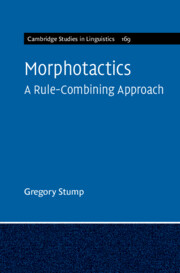Book contents
- Morphotactics
- Cambridge Studies in Linguistics
- Morphotactics
- Copyright page
- Dedication
- Contents
- Figures
- Tables
- Preface and Acknowledgments
- Abbreviations
- Symbols and Operators
- 1 Canonical Morphotactics
- 2 Rule Combinations
- 3 Dependent Rules and Carrier Rules
- 4 Rule Composition and Rule Ordering
- 5 Extending Canonical Morphotactic Criteria to Composite Rules
- 6 Rule Combinations Expressing Holistic Content
- 7 Rule Aggregation
- 8 Complex Morphotactic Interactions in Swahili
- 9 The Nonassociativity of Rule Composition in Murrinhpatha
- 10 Potentiation and Counterpotentiation
- 11 Rule Combinations and Morphological Simplicity
- 12 Rule‑combining Morphotactics and Morphological Theories
- 13 Conclusions
- References
- Index
12 - Rule‑combining Morphotactics and Morphological Theories
Published online by Cambridge University Press: 24 November 2022
- Morphotactics
- Cambridge Studies in Linguistics
- Morphotactics
- Copyright page
- Dedication
- Contents
- Figures
- Tables
- Preface and Acknowledgments
- Abbreviations
- Symbols and Operators
- 1 Canonical Morphotactics
- 2 Rule Combinations
- 3 Dependent Rules and Carrier Rules
- 4 Rule Composition and Rule Ordering
- 5 Extending Canonical Morphotactic Criteria to Composite Rules
- 6 Rule Combinations Expressing Holistic Content
- 7 Rule Aggregation
- 8 Complex Morphotactic Interactions in Swahili
- 9 The Nonassociativity of Rule Composition in Murrinhpatha
- 10 Potentiation and Counterpotentiation
- 11 Rule Combinations and Morphological Simplicity
- 12 Rule‑combining Morphotactics and Morphological Theories
- 13 Conclusions
- References
- Index
Summary
Situating the rule-combining approach to morphotactics in a wider theoretical context, I summarize its implications for the architecture of Paradigm Function Morphology and for schema unification in Construction Morphology. I further contrast the exponence-driven conception of morphotactics embodied by the rule-combining approach with the very different word-skeletal approach to morphotactics, drawing attention to two advantages of the rule-combining approach. First, it affords a more parsimonious inventory of morphological operations than is assumed in Distributed Morphology. Second, it avoids the cumbersome theoretical commitments of Information-based Morphology (the assumptions of position-based ordering, rule anchoring, and distributional pigeonholing), which entail numerous complications in the analysis of a language’s morphotactics. The distinct assumptions on which the rule-combining approach rests (those of combination-based ordering, unanchored rules, and distributional multidetermination) afford morphotactic analyses that are at once simpler and more explanatory.
Keywords
- Type
- Chapter
- Information
- MorphotacticsA Rule-Combining Approach, pp. 344 - 390Publisher: Cambridge University PressPrint publication year: 2022



